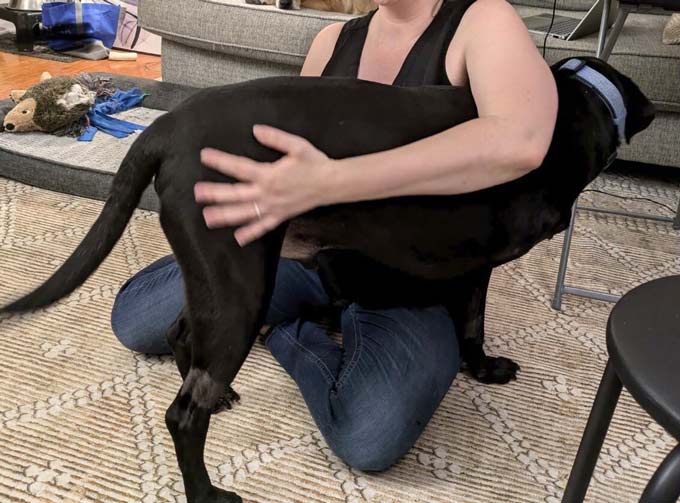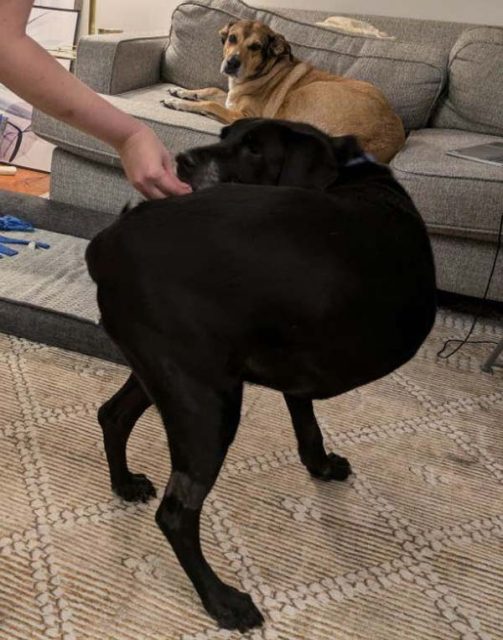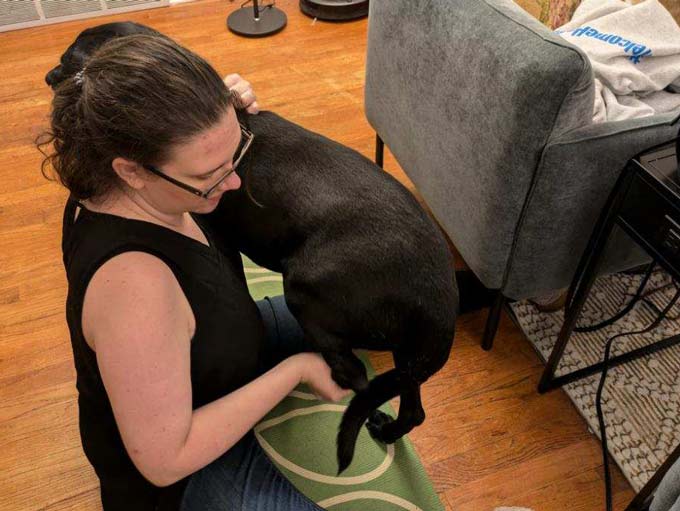Tripawd Moseley benefits from free canine rehab evaluation and at-home therapy thanks to Tripawds Foundation Rehab Grant #208. The consultation, and rehab exercises help Moseley stay strong and love life on three legs. Read his story, and learn how you can get a free veterinary rehab evaluation for your dog or cat.
Yes! Tri-kitties qualify for free feline rehab too. See all Tripawds who have received free rehab sessions thanks to your support.
Help Keep This Program Going!
Our dog Moseley is an eight-year-old black lab mix. We adopted Moseley when he was one year old from a small nonprofit in North Carolina, Hope Animal Rescue. Moseley became a Tripawd after he was diagnosed with osteosarcoma in June of 2024. He had been limping on his front right leg. The veterinarian initially thought Moseley had a sprain, but when the issue continued after a round of medication, x-rays were taken, and our fears had been confirmed. We were fortunate to be able to get an amputation surgery scheduled within one week of receiving the diagnosis. A few weeks after surgery, Moseley was able to start his chemotherapy treatments.
Although Tripawd Black Lab Moseley recovered reasonably well from his surgery, we still wanted to schedule him for a rehab appointment to help ensure his body was compensating correctly in ways that wouldn’t cause issues or complications for him in the long-term. We found an animal rehab clinic in our area called Companion Animal Rehab and Athletics.
How Rehab Helps Tripawd Black Lab Moseley
When the day finally arrived for our appointment at C.A.R.A., we met with Bethany Meno, DVM, CVA, CVSMT and Amanda Phelan, CVTA, NCCMT, CCRA (in progress). Dr. Meno and Amanda were wonderful with Moseley. First, Amanda and I went through a series of questions as she gathered information about Moseley’s background and situation. Then Bethany and Amanda worked together to take various measurements of Moseley and have him complete a series of movements to assess his mobility.

They were pleased with how well he was doing (he can do puppy push-ups like a pro), but they also noted areas of tightness in his musculature and his preference not to extend his right hindleg back as far as his left. This is perhaps one of the things I learned most from this experience as I was unaware of how tight some of his back muscles had become. They also noticed how he does not like his feet being touched, so that is something we are working with him at home now to desensitize him to having his feet touched. He was never a fan before, but it is definitely worse now as a Tripawd.
The initial exercises they gave us to work on at home until our next appointment were mainly to help strengthen his core and help him balance and shift his weight more evenly.

Moseley’s At Home Rehab Routine
First, we do a 3-legged stance (2-legged in Moseley’s case). We have Moseley stand on a surface with traction (yoga mat) and we lift his left hind leg, holding it for 5 seconds before setting it back down. We repeat 2-3 times per session with 3-4 sessions each week. The goal is to get to 10 seconds. This is to help balance out his preference for his left hind leg and strengthen his right hind leg, as well improving balance and core.
Next, we do Cookie stretches to the side and to the hip. Using a treat, we have Moseley turn his head and neck to follow the treat while standing. A problem for us is that Moseley has always been very good at sitting as soon as you bring out a treat. To keep him in a standing position while he learns this exercise, one of us has been sitting with our legs under him to discourage sitting. When we do these stretches, we want him to stop roughly at his shoulder and hold for 10-15 seconds. After repeating 3-4 times per side, we then do the same thing, but this time try and get Moseley to stretch to his hip. We try to make sure Moseley is standing on a surface with traction and in a square stance during these stretches. We complete these exercise sessions 3 times per week.

Finally, we do Rear Limb Weight Shifts. Ideally, we would be positioned behind Moseley with our hands placed on either side of his pelvis to support him. Again, because he wants to sit, one of us put our legs under him to discourage sitting. While he is standing in a square position, we gently push him in one direction and then the other in a slow rhythmic sway. We do this daily for about 5-10 times depending on Moseley’s patience. As his balance improves, the goal is to increase the speed.
We found the Tripawds website through Google searches initially after Moseley’s diagnosis, but our veterinarians also recommended the site and were pleased we had already come across the resources in our research. I can’t imagine going through this process with Moseley without the many resources available on the Tripawds site. Thank you so much!
~ Elizabeth and Tripawd Moseley
